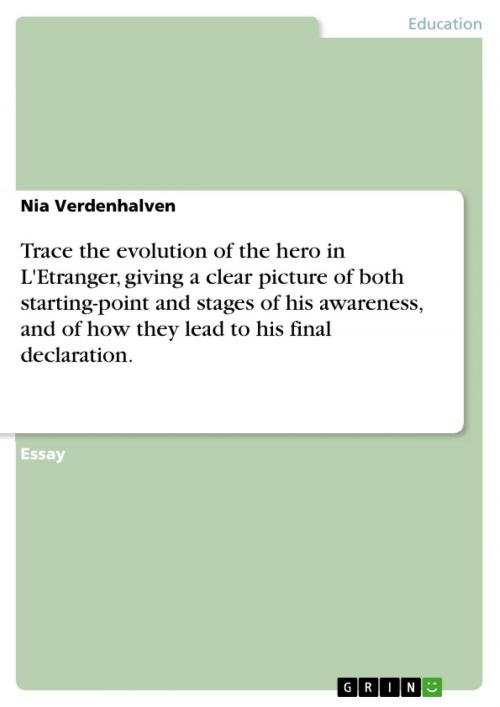Trace the evolution of the hero in L'Etranger, giving a clear picture of both starting-point and stages of his awareness, and of how they lead to his final declaration.
Nonfiction, Reference & Language, French Language| Author: | Nia Verdenhalven | ISBN: | 9783638631082 |
| Publisher: | GRIN Verlag | Publication: | March 31, 2007 |
| Imprint: | GRIN Verlag | Language: | English |
| Author: | Nia Verdenhalven |
| ISBN: | 9783638631082 |
| Publisher: | GRIN Verlag |
| Publication: | March 31, 2007 |
| Imprint: | GRIN Verlag |
| Language: | English |
Essay from the year 2007 in the subject French - Literature, Works, grade: B+/2+, University of London, 9 entries in the bibliography, language: English, abstract: Soon after L'Etranger was first published in 1942 it became a major success and it is now regarded as a twentieth-century classic. Since then numerous attempts have been made to analyse the fascinating but unsettling story of the main character, Meursault, in order to find explanations for his motives and actions. This essay will try to demonstrate that there are three main parts in this diary-style novel, in which death plays a key role. Beginning with the moment when carefree and indifferent Meursault learns about the death of his mother, followed by the fateful day when he kills the Arab, and eventually leading to his growing awareness and passion for life through confrontation of his oncoming execution.
Essay from the year 2007 in the subject French - Literature, Works, grade: B+/2+, University of London, 9 entries in the bibliography, language: English, abstract: Soon after L'Etranger was first published in 1942 it became a major success and it is now regarded as a twentieth-century classic. Since then numerous attempts have been made to analyse the fascinating but unsettling story of the main character, Meursault, in order to find explanations for his motives and actions. This essay will try to demonstrate that there are three main parts in this diary-style novel, in which death plays a key role. Beginning with the moment when carefree and indifferent Meursault learns about the death of his mother, followed by the fateful day when he kills the Arab, and eventually leading to his growing awareness and passion for life through confrontation of his oncoming execution.















